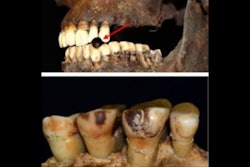A recent fascinating yet melancholy archeological discovery in Germany has uncovered ornately arranged drilled canine teeth that were likely used to adorn infant carriers, according to the State Office for Heritage Management and Archeology of Saxony-Anhalt.
Workers preparing to install a high-voltage power line in eastern Germany discovered the gravesite, which is located near Krauschwitz, near Germany’s border with Poland, according to the office’s July 9 announcement.
They uncovered the remains of multiple women and infants dating back to 4,500 BCE. A toothworthy discovery, though, were drilled canine teeth found among the remains. It’s believed the canine teeth were affixed to leather or fabric bags that held their human cargo but have since been claimed by decomposition.
The canine dentition was arranged in elaborate patterns like roofing shingles, according to the announcement. Archeologists estimate the infant carriers measured 11.8 x 7.9 inches and featured as many as 350 canine teeth. The teeth resemble the small Munsterland pointer, a hunting dog in Europe, the announcement states.
Working with multiple sets of remains, workers believe the infants were placed inside these carriers or close to the bags when they were laid to rest.
The findings are particularly poignant for several reasons, including they likely served a ceremonial but practical function. The location of the teeth in relation to the bones suggests the bags were slung around the torso. Some of the infants' heads and limbs were wrapped in scarflike textiles that were also adorned with canine molars, which could have protected children from the harsh elements.
Additionally, archeologists theorize that based on the elaborate arrangement of the teeth, the women may have been regarded as elite members of their community. Finally, the somber discovery speaks to the care with which these women and children were laid to rest.
This isn’t the only discovery workers on the 105-mile power line have made. Archeologists also discovered older burial mounds dating back to 4,000 BCE that included wooden trapezoidal structures covered in loess, a fine soil. Archeologists deduce that the site held a special place of reverence and significance for late Neolithic people.
Archeologists will continue working on the site until the end of July 2025. Items will be carefully removed and likely displayed in museums, according to the announcement.



















